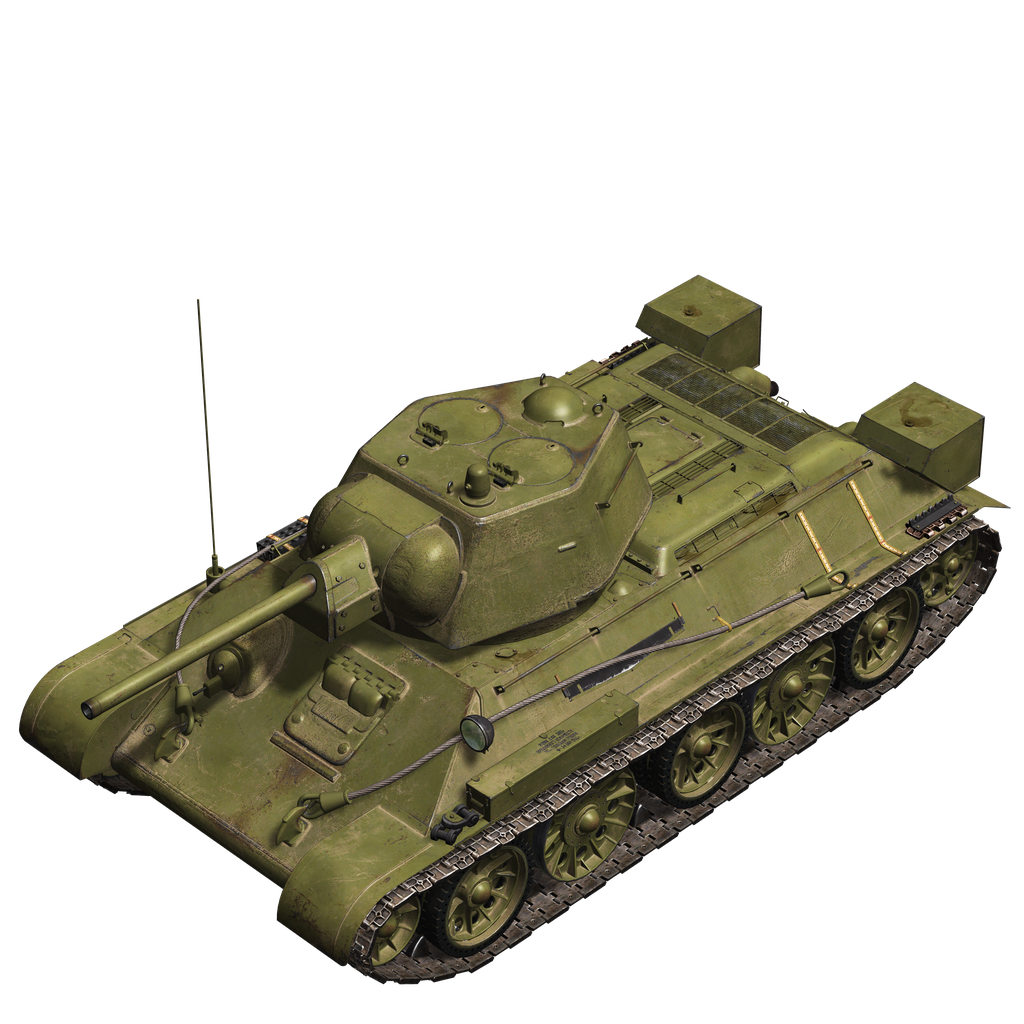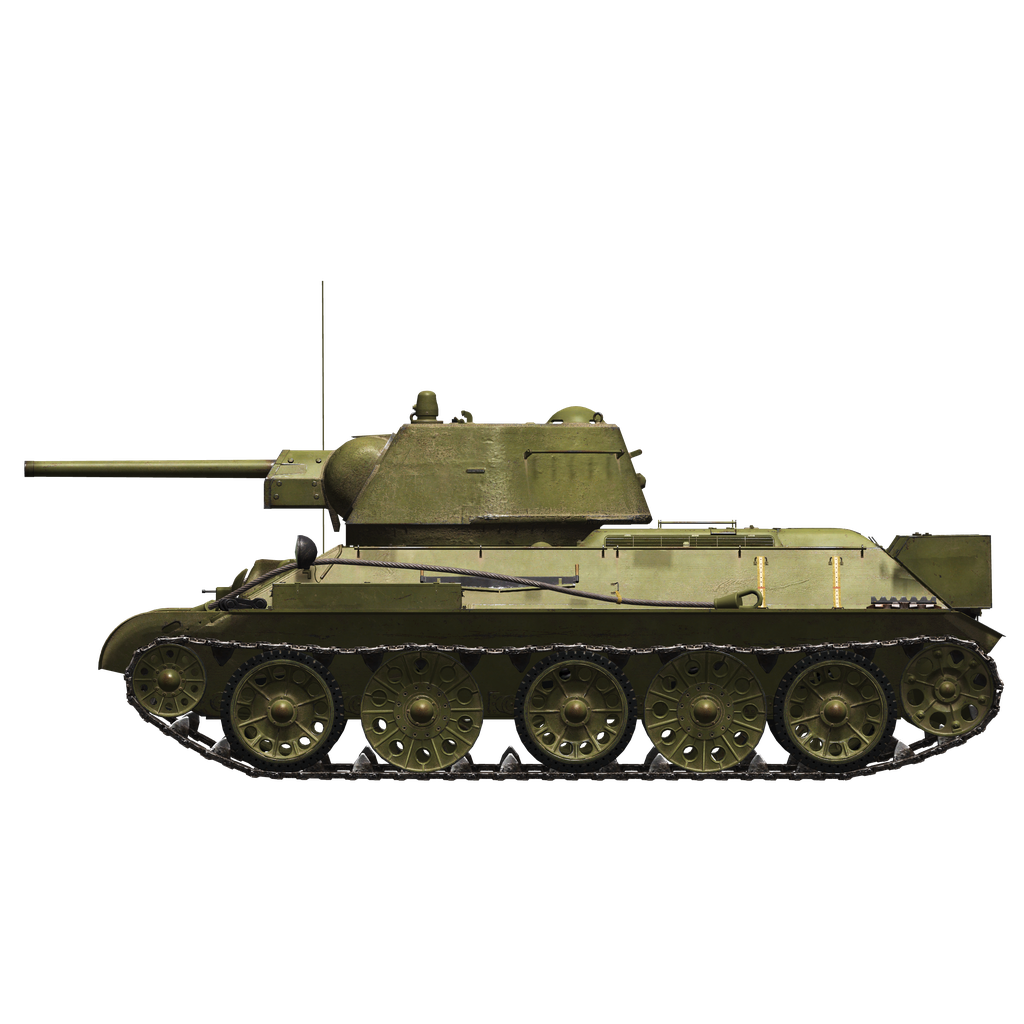In 1938 a new wheeled tracked tank was developed in Kharkov to replace the BT series tanks, and on the basis of this project a pure tracked tank with improved armor protection and weapons was created on the design team’s own initiative, called the A-32. As a result of the modification of the A-32, the T-34 tank appeared, which eventually became the most numerous tank of the Second World War.
Production of the T-34-76 tank began in 1940 and continued until 1944. The T-34 was produced in 6 plants, which were repeatedly modified according to their production capabilities and the requirements of the front. One of these plants was the Ural Tank Plant No. 183 (UTZ, today Uralvagonzavod in Nizhny Tagil). On December 18, 1941, the first T-34-76 tank rolled off this assembly line, and then the first batch of 25 vehicles were sent to the front. In 1943 the plant began producing a version of the tank with a new turret and improved transmission.
The T-34-76 produced by UTZ had a classic layout with rear-mounted transmission. The hull, welded from rolled armor plates, was simplified by standardizing the armor plates, which were either 45 or 20 mm thick. The internal tank was divided into 4 compartments: control, fighting, engine, and transmission.
The control compartment was located at the front of the tank and contained the driver's and radio operator's seats, control levers, control instruments, a radio station, a forward machine gun and its ammunition, compressed air cylinders for the emergency engine starting system, and spare parts for tools. The driver's hatch was located on the inclined front plate of the hull.
The fighting compartment was located in the middle of the vehicle. It housed the seats of the tank commander (who was also the gunner) and the turret gunner (who was also the loader). Above the fighting compartment a turret was installed, which housed weapons, part of the ammunition and observation equipment. From the fall of 1942 the turret design was simplified to facilitate production; it had a hexagonal shape and was cast. There were 2 crew hatches in the turret roof.
The engine compartment was located behind the fighting compartment in the middle part of the tank and was separated from it by a continuous folding partition with hatches. This series was often equipped with a new 5-speed transmission, which made shifting gears easier.
In the transmission compartment in the rear part, there were mechanical transmission units and 2 fuel tanks. The tanks of this modification also had external fuel tanks.
Rubber-coated rollers were introduced for better shock absorption, but due to rubber shortages, they were often paired with the older type of uncoated wheels.
The armament included a 76 mm F-34 model 1940 cannon with a 41.6 caliber barrel and two rifle-caliber machine guns. The types of projectiles were as follows: armor-piercing BR-350B (weight 6.5 kg, initial speed 660 m/s, armor penetration 72 mm at a distance of 500 m), armor-piercing solid BR-350BSP (6.6 kg, 660 m/s, 73 mm at 500 m), sub-caliber BR-354P (3.02 kg, 950 m/s, 129 mm at close range), and high-explosive fragmentation OF-350 (6.2 kg, 680 m/s).
In total, UTZ produced at least 9,500 tanks of this modification in 1942-1943. The T-34 was in combat from the beginning of the Great Patriotic War and in 1941-1942 they surpassed the main tanks of the Wehrmacht in combat effectiveness, but until 1943 their number in the fleet of combat vehicles did not exceed 30%. The T-34 became the main battle tank of the Red Army only in 1943 and bore the brunt of the most brutal tank battles at the Kursk Bulge and subsequent battles in 1943. In connection with the appearance of new German tanks and an increase in the caliber of the Wehrmacht's antitank artillery, it became clear that the T-34 was already not up to the tasks assigned to it, so the T-34-85 with a more powerful gun was introduced, and the number of T-34-76s at the front steadily decreased. The surviving vehicles took part in all operations of the Red Army in 1944-1945 but were mainly used as training vehicles in the rear units.
Used sources:
1. M. Baryatinsky “T-34. History of the tank”, magazine “Armor Collection” No. 03 2003
2. M. Svirin “Tank power of the USSR. Part 2 “In difficult times" 2009
3. “Kharkov Mechanical Engineering Design Bureau named after A.A. Morozov" 1997
T-34 built by F.E. Dzerzhinsky Ural Tank Factory #183 (UTZ) in Spring 1943. These tanks had distinct hexagon cast turrets with sharp bilges, mixed cast (with internal dampeners) and rubber-coated wheels, and external fuel tanks at the rear. Rubber-coated wheels were introduced for better cushioning, but because of the rubber shortage in the USSR, they were mixed with older type wheels.
The tank design has been simplified by reducing the number of different types of armour sheets, so sides, rear, bottom, roof and bottom above tracks armour thickness increased - 40 mm armour sheets were replaced by 45 mm ones and 13-16 mm sheets by 20 mm ones. The new cast turret also was 5-11% more durable depending on the hit angle.
In addition, the tanks made during this time usually had the new 5-gear gearbox installed for more effective acceleration and cross-country capacity. Main gun ammo has been increased to 100 rounds.
Unladen weight: ~30000 kg.
Length: 6.6 m.
Width: 3.0 m.
Height: 2.5 m.
Clearance: 400 mm.
Engine: V-2 diesel.
Maximum power: 500 HP at 1800 RPM.
Maximum RPM: 1900 RPM.
5 speed gearbox.
Maximum road speed:
1-st gear: 7.4 kph.
2-nd: 15.9 kph.
3-rd: 22.4 kph.
4-th: 34.1 kph.
5-th: 54.0 kph.
Reverse: 8.4 kph.
Maximum offroad speed: 31 kph.
Fluids:
Internal fuel tanks capacity: 460 l.
Engine oil system capacity: 80 l.
Summer engine coolant: 95 l. of water
Winter engine coolant: 95 l. of 50% ethylene-glycol
Endurance range: 300 km.
Maximum oil consumption: 9 l/h.
Hull armour:
Front: 45 mm.
Sides: 45 mm rolled armour.
Rear: 45 mm rolled armour.
Roof: 20 mm rolled armour.
Bottom: 20 mm rolled armour.
Bottom above tracks: 20 mm rolled armour.
Turret armour:
Front: 56 mm cast armour.
Sides: 56 mm cast armour.
Rear: 56 mm cast armour.
Roof: 56 mm cast armour.
Gun mantlet: 45 mm rolled armour.
Main gun: rifled, 76.2 mm F-34.
Barrel length: 41.6.
Elevation: +25°..-5°.
Ammo: up to 100 rounds.
Usable rate of fire: 8 rounds per minute.
Turret drive: electric, 14 seconds per rotation.
Gun ammunition:
BR-350B armour piercing high explosive (APHE): 6.5 kg, 660 m/s, 72 mm at 500 m.
BR-350BSP armor piercing solid (AP): 6.6 kg, 660 m/s, 73 mm at 500 m.
BR-354P armour piercing composite rigid (APCR): 3.02 kg, 950 m/s, 129 mm point blank.
OF-350 high explosive (HE): 6.2 kg, 680 m/s, 710 g. explosives.
Machineguns: 7.62 mm Degtyarev (DT).
Bullet mass: 9.8 g.
Muzzle velocity: 840 m/s.
Armour pentration at 100 m: 11 mm.
Rate of fire: 600 rounds per minute.
Coaxial: 29 mags, 63 rounds per each (1827 rounds).
Bow: +-12°/+16°..-6°, 23 mags, 63 rounds per each (1449 rounds).
Gunsights:
TMFD-7 gunner scope-sight, field of view 15°.
PT4-7 gunner panoramic periscopic sight, field of view 26°.
Radio equipment:
VHF 9-RM transceiver.
3 intercom terminals.





